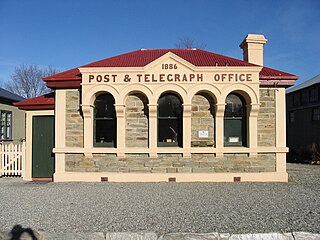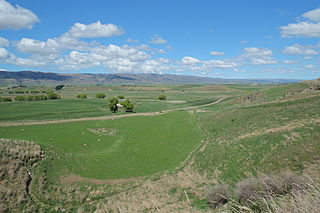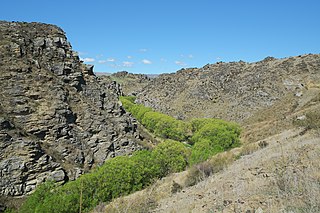
Riverton is a small town 30 kilometres west of Invercargill and located on the south-eastern shorelines of the Jacobs River Estuary. This is formed by the Aparima and Pourakino rivers, leading through a narrow outflow channel into Foveaux Strait. Accessible via State Highway 99 on the Southern Scenic Route, the main part of the town is on flat land and the northern end of Oreti Beach. South Riverton is built on the hills between the eastern shore of the estuary and Taramea Bay.

Alexandra is a town in the Central Otago district of the South Island of New Zealand. It is on the banks of the Clutha River, on State Highway 8, 188 kilometres (117 mi) by road from Dunedin and 33 kilometres (21 mi) south of Cromwell. The nearest towns to Alexandra via state highway 8 are Clyde seven kilometers to the northwest and Roxburgh forty kilometers to the south. State highway 85 also connects Alexandra to Omakau, Lauder, Oturehua, Ranfurly and on to Palmerston on the East Otago coast.

The Clutha River, officially Clutha / Mata-Au, is the second longest river in New Zealand and the longest in the South Island. It flows south-southeast 338 kilometres (210 mi) through Central and South Otago from Lake Wānaka in the Southern Alps / Kā Tiritiri o te Moana to the Pacific Ocean, 75 kilometres (47 mi) south west of Dunedin. It is the highest volume river in New Zealand, and the swiftest, with a catchment of 21,960 square kilometres (8,480 sq mi), discharging a mean flow of 614 cubic metres per second (21,700 cu ft/s). The Clutha River is known for its scenery, gold-rush history, and swift turquoise waters. A river conservation group, the Clutha Mata-Au River Parkway Group, is working to establish a regional river parkway, with a trail, along the entire river corridor.

The Haast River / Awarua is a river on the West Coast of the South Island of New Zealand.
Central Otago is located in the inland part of the Otago region in the South Island of New Zealand. The motto for the area is "A World of Difference".

The Kawarau River is a river in the South Island of New Zealand. It drains Lake Wakatipu in northwestern Otago via the lake's Frankton Arm. The river flows generally eastwards for about 60 kilometres (37 mi) and passes through the steep Kawarau Gorge until it joins Lake Dunstan near Cromwell. Before the construction of the Clyde High Dam, the Kawerau joined the Clutha River / Mata-au in a spectacular confluence at Cromwell. The Shotover River enters the Kawerau from the north; the Nevis River enters it from the south. With many rapids and strong currents, the river can be dangerous and has claimed many lives: it is also popular for bungy jumping and kayaking.
West Otago is the local name given to part of the region of Otago, New Zealand, lying close to the border with Southland. It is administratively connected to South Otago, but is geographically separated from it by a range of hills known as the Blue Mountains. The largest settlements in West Otago are Tapanui and Heriot, and other localities within the area include Moa Flat, Edievale, Crookston, Merino Downs, and Waikoikoi. The area described as West Otago is sometimes extended to include Lawrence, Clinton, and Beaumont. The ghost town of Kelso also lies within West Otago. Other notable features of the area include Conical Hill and Landslip Hill, the latter being a major fossil-bearing formation.

The Maniototo Plain, usually simply known as The Maniototo, is an elevated inland region in Otago, New Zealand. The region roughly surrounds the upper reaches of the Taieri River and the Manuherikia River. It is bounded by the Kakanui Range to the north and the Rock and Pillar Range to the southeast. It has a harsh, dry climate, ranging from over 30 °C in mid-summer to -15 °C in mid-winter.

The former gold and coal mining town of St Bathans, formerly named Dunstan Creek, lies deep in the heart of the Maniototo in New Zealand's Otago region. The settlement was a centre of the Otago Gold Rush, but mining has since long ceased and it is now a tranquil holiday retreat. The preservation of many of its historic buildings makes it one of the region's more picturesque tourist venues. St Bathans is well known for its scenic man-made lake with beautiful looking clay cliffs that attract many tourists. It is currently a camping spot, and swimming is allowed in the lake.

The Central Otago wine region is a geographic indication in New Zealand's South Island, and the world's southernmost commercial wine growing region. Central Otago is best known for Pinot Noir, but many white wine varieties are also popular.
Paerau is a small settlement in inland Central Otago in New Zealand's South Island. It is located in the Strath Taieri, the upper valley of the Taieri River, at the foot of the Rock and Pillar Range. "Paerau" is a Māori-language name meaning "one hundred ridges".

Omakau is a settlement in Central Otago, New Zealand, located between Alexandra and Ranfurly on the northwest bank of the Manuherikia River. The smaller settlement of Ophir, New Zealand is located on the opposite bank, three kilometres to the southeast.

Ophir is a small settlement in Central Otago, New Zealand, located between Alexandra and Ranfurly close to the east bank of the Manuherikia River. The settlement of Omakau is located on the opposite bank, 3 kilometres (1.9 mi) to the northwest.

The Ida Valley lies east of the Manuherikia Valley in Central Otago, New Zealand. At an altitude of around 500 m (1,600 ft), the 40 km long flat and wide valley is a relatively dry region with cold winters and hot summers, much like the rest of Central Otago. The majority of agricultural production in the Ida Valley is lamb, including merino, and also stud cattle.

The Poolburn Gorge is a gorge located in the Central Otago region of the South Island of New Zealand, 4 km east of the small settlement of Lauder. The Ida Burn flows through the 2.5 km long canyon across the Raggedy Range between the Ida Valley and the Manuherikia Valley. There are no public roads through the gorge; only the track of the former Otago Central Railway, now used as the Otago Central Rail Trail, follows the river on the southern flanks of the gorge.

The Manuherikia Group is a fluvial-lacustrine sedimentary fill in the Central Otago region of New Zealand, at the site of the prehistoric Lake Manuherikia. The area consists of a valley and ridge topography, with a series of schist-greywacke mountains at roughly ninety degrees to each other. The Manuherika Group occurs in the current basins, and occasionally on the mountains themselves.

Becks is a small settlement in the Otago Region of the South Island of New Zealand. It is located on State Highway 85, some 16 kilometres (9.9 mi) north-east of Omakau, and just west of where the State Highway crosses the Manuherikia River. It lies on the 45th parallel south.

Poolburn Reservoir, also known as Poolburn Dam, is a reservoir in Central Otago, New Zealand. Built during the Great Depression for irrigation but also as an employment initiative, the water is used by farmers in the Ida Valley.
Poolburn is a small rural settlement in Central Otago, in the South Island of New Zealand. It is located in the Ida Valley nine kilometres to the southeast of Ophir. It has a Primary School, a former Hotel, a community Hall,sports ground, tennis courts and a (closed) church. It has nearby historic gold mine workings at the eastern foot of the Raggedy Range.
The Dunstan Trail, also known as the Old Dunstan Road, is a historic route in Otago, New Zealand. The road was created during the Central Otago Gold Rush of the 1860s.














